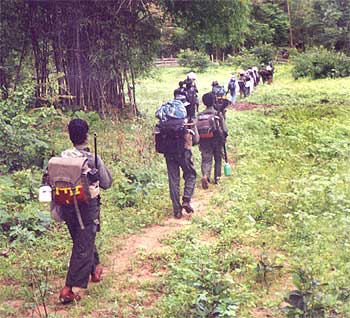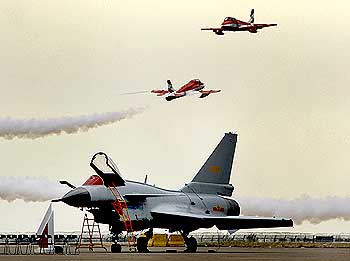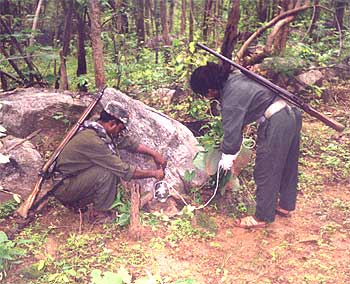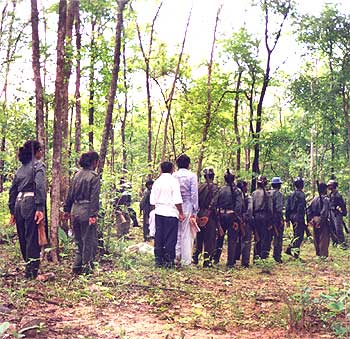Photographs: : Chindu Sreedharan
The Naxals fury is taking India by the storm. SG Inamdar looks into the pros and cons of deploying Air Force in the anti-Maoist operations.
We have used the Air Force firepower with telling, if not decisive, effect in the past, in serious insurgency situations bordering on armed revolt/ secession, in the 60s, in a part of our country. It is nothing new.
Those decisions must have been hard to take and painful to arrive at, at the highest political levels; what perhaps helped was that, after a certain stage, it was largely the Army, and not the CPF, which was doing the bulk of the fighting on the ground; the scenarios had turned into a quasi-war one and time was fast running out.
Once the decisions were taken, the go-aheads were given and the overall guidelines spelt out clearly by the Centre, the Air Force & the Army were left pretty much alone to do their own joint planning, prioritizing and execution. They used the AF fire power most astutely, judiciously, conservatively and correctly to avoid collateral damage beyond a point, mindless mayhem and wanton destruction of civilian life and property. I state this from first-hand experience, observation and knowledge.
Not using the Air Force fire power when and in the manner in which it was used at the time, would, to my mind, have been disastrous for the nation. Merely using it in the logistics, communication, transportation of men & materiel, surveillance, air maintenance and casualty evacuation roles wasn't getting us the needed dividends.
Air Marshal (retired) S G Inamdar is former Vice Chief of the IAF
'Even the Army can join'
Image: Air Force aircraft. A file picturePhotographs: Reuters
As it was revealed once peace and order were restored to those troubled areas later on, aerial firepower could not have been used more opportunely and appropriately; it, along with the Army ground action, possibly pulled a lot of political chestnuts out of the fire just in time, shortened the conflict very considerably and nipped in the bud what would have turned into a serious challenge to India's integrity! I would like to believe that it also served as a major and punishing lesson to the then and future separatists, without and most importantly, estranging the populace.
The Naxal menace of today is indeed vastly different, both in character and content as also in its origins and geographical areas of operation; the times have changed a great deal and so have the nature and extent of media coverage, since the insurrections of the 1960s.
However and these notwithstanding, revisiting the air operations mentioned above (both, logistic/ civilian relief and offensive), the decision-reaching process then, the lessons learnt (more by the then separatists/ insurgents) and carefully extrapolating all that info to the Naxal problem today, may be useful in the present debate on the possible use of firepower from the skies.
Repeated public skepticism on its use or its declared non-use could well be something the Naxal cadres will heavily pin their hopes on and factor into their operations!
..but don't be in a haste
Image: Another file picture from a Naxal denThe Air Force firepower is and has been an outstanding resource--in surprise, speed, devastation and psychological impact-- whether it was insurgencies of the 1960s or Kargil operations of 1999. It has historically been in its very nature to strike awe and fear into the hearts of less-than-well-trained-and-motivated troops (and some times even them!), quite out of proportion with the weight of attack and physical damage done.
I feel it is waiting to be prudently, carefully, selectively or even minimally used in anti-Naxal operations, albeit with calculated regard for a possible modicum of AD weapons availability with the 21st century insurgent which his 1960s counterpart did not possess.
Be that as it may, we would be very ill advised to take a hasty or peremptory stand against using it merely to be in line with some of the ongoing NGO rhetoric, until after due deliberation on the lines I have suggested.
A question that often begs answer is: do human rights unquestioningly and unconditionally apply to such groups as have manifestly and repeatedly shown utter contempt for the lives of civilian employees and police personnel, unless of course these latter categories are no more entitled to human rights?! For those among us who fondly imagine that the Naxal menace can be simply wished away by placating and soft-pedalling alone, they have a surprise coming their way....a BIG one at that! I only hope it is later than sooner!!
'Situation worrisome'
Image: Where will the Maoists draw the lineBefore getting branded as an unabashed hawk, let me hasten to add that the use of Air Force firepower does not and must not preclude such political processes as aim to address the crucial socio-economic issues underlying the Naxal movement.
The two supplement and complement each other and are not, therefore, at all mutually exclusive. Oftentimes there may not be enough time but there will always be enough space for them to go on side by side. There is also no question of the stick preceding the carrot.
It will probably be the certainty in the minds of Naxal ideologues of such a two-track approach being adopted, which will end or at least hasten the end of this insurgency. The spectre of its swathe-like rapid spread from the North East to the SW of India, is extremely worrisome, to put it mildly.





article